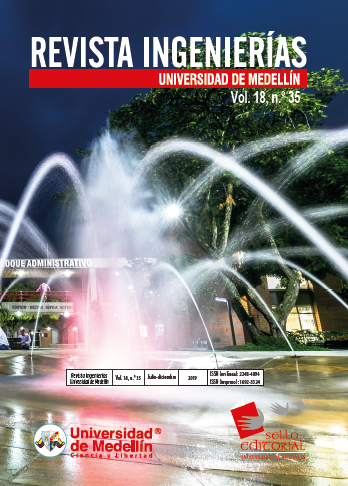Study of the Effect of the Geometry of a Typical Solar Dryer for Coffee Using CFD
DOI:
https://doi.org/10.22395/rium.v18n35a9Keywords:
agroindustry, computational fluid dynamics, simulation, energy, temperature, radiation, solar dryerAbstract
The objective of the present investigation was to computationally model a typical solar dryer for coffee, considering some alternative geometric configurations in the opening of windows to improve the thermal conditions within the drying structure which enable the water removal process of wet parchment coffee. The model was simulated in Ansys CFX® software. Simulation results showed that the geometry with an opening of 25 % in the air output window increased temperature in the coffee layer to 4.2 °C over room temperature, guaranteeing uniform drying, whereas the typical geometry with a 100 % opening increased temperature to 3.8 °C. When the maximum window opening for input and output of air was used, the relative humidity of air within the dryer decreased in comparison with the other geometries.
Downloads
References
[1] B. Soediono, “Beneficio del café II: secado del cafe pergamino,†J. Chem. Inf. Model., vol. 53, p. 160, 1989.
[2] A. G. Ferreira, C. B. Maia, M. F. B. Cortez, and R. M. Valle, “Technical feasibility assessment of a solar chimney for food drying,†Sol. Energy, vol. 82, n.º 3, pp. 198-205, 2008.
[3] C. Brasil, A. Ferreira, L. Cabezas, S. Morais y T. Oliveira Martins, “Simulation of the airflow inside a hybrid dryer,†Arpapress, vol. 10, n.º 3, pp. 382-389, 2012.
[4] Y. Amanlou and A. Zomorodian, “Applying CFD for designing a new fruit cabinet dryer,†J. Food Eng., vol. 101, no. 1, pp. 8-15, 2010.
[5] R. Alvarez and J. Santamaria, “Dinámica de fluidos computacional aplicada al estudio de regeneradores térmicos,†Dyna, vol. 71, no. March, pp. 81-93, 2004.
[6] W. Nilnont, S. Thepa, S. Janjai, N. Kasayapanand, C. Thamrongmas, and B. K. Bala, “Finite element simulation for coffee (Coffea arabica) drying,†Food Bioprod. Process., vol. 90, n.º 2, pp. 341-350, 2012.
[7] Ideam, “Clima,†Ideam, [En lÃnea], Disponible: http://www.ideam.gov.co/web/tiempo-y-clima/clima?inheritRedirect=true, 2010
[8] I. Campbell Scientific, “CR1000 Measurement and Control System,†Campbell Scientific, Logan, Utah, pp. 1-678. Disponible: https://shop.profec-ventus.com/images/Datasheets/Data_loggers/SCI/CR1000/cr1000-manual-2015.pdf, 2015.
[9] J. M. Jurado-Chaná, E. C. Montoya-Restrepo, C. E. Oliveros-Tascón, and J. GarcÃa-Alzate, “Método para medir el contenido de humedad del café pergamino en el secado solar del café,†vol. 60, n.º 2, pp. 135-147, 2009.
[10] J. Osorio, I. Ferreira, K. Olivera, L. Barreto, and T. Norton, “a Cfd Based Approach for Determination of Ammonia Concentration Profile and Flux From Poultry Houses With Natural Ventilation,†Rev. Fac. Nac. Agron., vol. 69, n.º 1, pp. 7825-7834, 2016.
[11] Ansys, Ansys CFX-Solver Theory Guide, Canonsburg, Pensilvania: Ansys, 2013.
[12] C. B. Alvarenga et al., “Effect of the water vapor pressure deficit in the air on hydropneumatic spraying of artificial targets,†Biosci. J., vol. 30, n.º 1, pp. 182-193, 2014.
[13] P. Verboven, A. K. Datta, N. T. Anh, N. Scheerlinck, and B. M. Nicolaı̈, “Computation of airflow effects on heat and mass transfer in a microwave oven,†J. Food Eng., vol. 59, n.º 2-3, pp. 181-190, 2003.
[14] J. Besora, “Informe Técnico para la Construcción de un Secador Solar de Café,†Ing. Sin Front., 2016.
[15] S. Janjai, P. Intawee, J. Kaewkiew, C. Sritus, and V. Khamvongsa, “A large-scale solar greenhouse dryer using polycarbonate cover: Modeling and testing in a tropical environment of Lao People’s Democratic Republic,†Renew. Energy, vol. 36, n.º 3, pp. 1053-1062, 2011.
[16] J. Henao, “Evaluación del proceso de secado del café y su relación con las propiedades fÃsicas, composición quÃmica y calidad en taza,†Tesis, Universidad Nacional de Colombia, sede MedellÃn, 2016.
Downloads
Published
How to Cite
Issue
Section
License
The total or partial reproduction of the contents of the journal for educational, research, or academic purposes is authorized as long as the source is cited. For reproduction for other purposes, express authorization from the Sello Editorial Universidad de MedellÃn is required.

